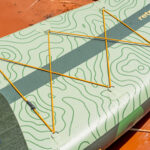The Retrospec Weekender is a no-frills all-round iSUP from a brand who know a thing or two about paddleboarding so we were curious to see what they could actually deliver at this super-competitive price.

The Weekender has been in the Retrospec range for several years as their entry-level all round general purpose stand up paddleboard. This year, in order to balance the range with the more recent and higher tech Plus and Tour editions, the price of the Weekender has been reduced to an exceptionally competitive $249. So what do you get for the money, and how does the Weekender fare against the higher spec models in the Retrospec range?
At first glance, the Retrospec range can appear slightly confusing: Why so many boards of seemingly the same size? Let’s start by explaining what’s going on.
10 ‘6 is historically the preferred size for a general purpose all round stand up paddleboard.
The Retrospec Weekender reviewed here is the basic model at this size.
The Retrospec Weekender Yogi has a slightly more modern shape to give extra stability, and it has a larger deckpad to increase its suitability for yoga, or just carrying more people and stuff. It also has a few extra fittings such as front and back carrying handles, and costs an extra $50.
The Retrospec Weekender Plus also has that slightly more modern shape, with a more robust construction, extra fittings (more handles, cargo carrying capacity, paddle holder etc) and a kayak seat conversion included, all for an extra $100.
All three of these general purpose options represent great value. Indeed, if you can afford the extra outlay we’d suggest that the Plus or Yogi offers a better package overall, plus that extra stability. But if you’re looking to minimize your expenditure then the Weekender we’re reviewing here certainly has a very attractive price tag, and still does a great job. So let’s look at what you’re getting for your money.
We think the Retrospec Weekender would be a great SUP for paddlers who:
- Just want a simple functional paddleboard to get out onto the water with.
- Appreciate a board that is light and easy to carry
- Want to keep their expenditure to a minimum, but still desire something with reasonable quality.
Retrospec Weekender: Spec Sheet

- Board Category: All-round
- Listed Board Dimensions: 10’6 x 32” x 6”
- Measured Board Dimensions: 10’7” x 32.5” x 6”
- Listed Board Weight: 17.5lbs
- Actual Board Weight (board only, not inflated): 22 lbs
- Full kit weight (measured): 34.6 lbs
- Listed Max Capacity: 275 lbs
- Recommended PSI: 12-15psi
- Fins: 1 center & 2 side fins (all removable)
- Paddle: 3 piece alu/nylon paddle
- Board Shell Construction Materials: Single layer
- Drop-stitch type: knitted
- Price Range: $249
- Warranty: 50 day return period, 2 year warranty
Performance Review of the Retrospec Weekender Stand Up Paddle Board

Overall Score: 8.3/10
- Stability: 8.7/10
- Speed: 8.6/10
- Tracking: 8.6/10
- Maneuverability: 8.8/10
- Construction Quality: 8.0/10
- Features/Accessories: 7.0/10
Stability Rating: 8.7/10
The plan shape and dimensions of Retrospec Weekender are typical for an all round board. Literally millions of people have learned to paddleboard on boards of this size and shape over the last 15 years. In recent times the trend in all-round board design has been towards wider tails which offer even more stability, as can be seen in the newer models in the Retrospec range. So in comparison, this model is actually the least stable in their line up of 10’6 all rounders.
Nevertheless, for paddlers of 175 lbs or less, it will still be a comfortably stable platform for general paddling. If you’re heavier than this, and/or wanting to carry significant cargo, or use your board for multiple riders or sharing with pets, then you will find the Yogi or Plus an easier option.
For paddlers significantly lighter than 175 lbs it offers plenty of stability, and will perform well as a board to learn on or for any sort of general summer on-the-water fun. (Indeed if you’re a lot lighter than 175 lbs it’s probably the best choice in the range when it comes to paddling performance).


Speed Test: 8.6/10
| Board | |
| Sprint Speed: | 4.7 MPH |
| Average Cruising Speed: | 3.3 MPH |
To obtain our speed test results, we use a Speed Coach Sup 2. This gives us accurate readings on how fast we are paddling and our current stroke rates. For the sprint speed, we paddle as hard as we can for approximately 10-15 seconds and then record our average speed. For the casual test, we paddle at 35-40 strokes per minute for approximately 30-60 seconds and record the average speed.
Because the Weekender is extremely light you don’t need to work too hard to keep the board moving forward, and it cruises at a respectably comfortable pace. Likewise, when you paddle a bit harder, the light weight again makes it feel quite lively and ready to accelerate.
Eventually the somewhat flexible nature of the construction makes itself apparent, and the board reaches a top speed beyond which it really doesn’t want to be driven, particularly in more bumpy water conditions, when the wide rounded nose gets knocked around quite a bit.
However, this is typical of most all rounders, and overall we were pleasantly surprised by the board’s general cruising performance. If you’re wanting something for more sustained faster paddling then check out the Retrospec Weekender Tour, which is designed much more with this in mind.
Tracking: 8.6/10
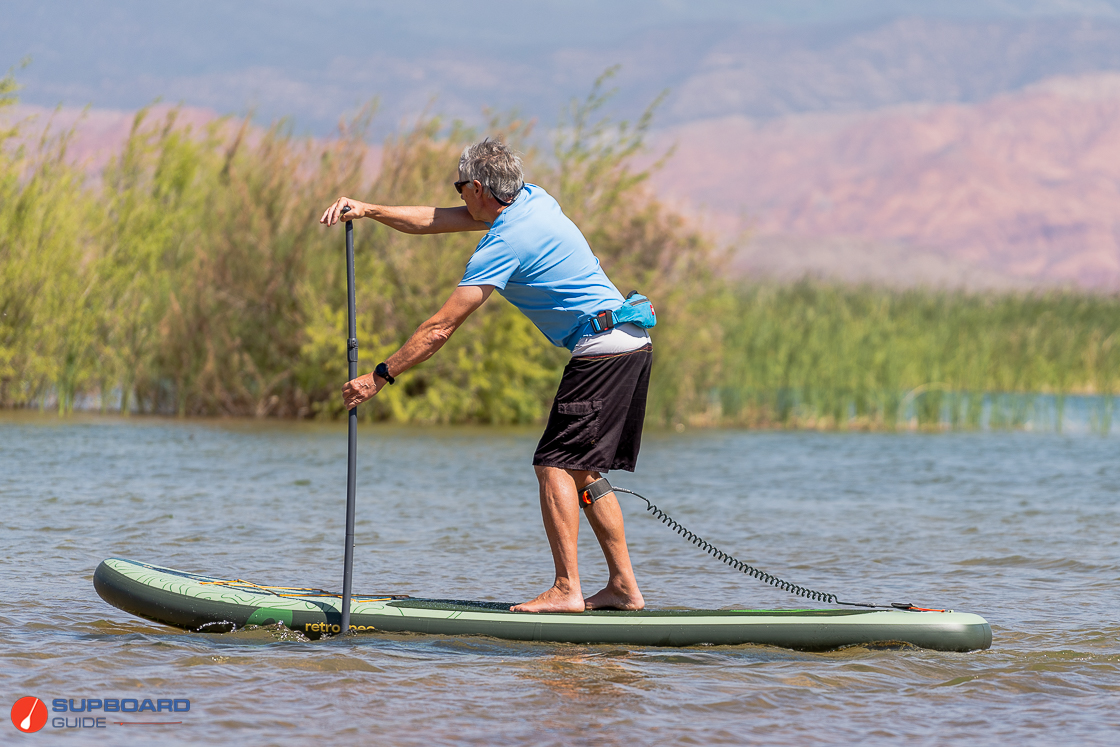
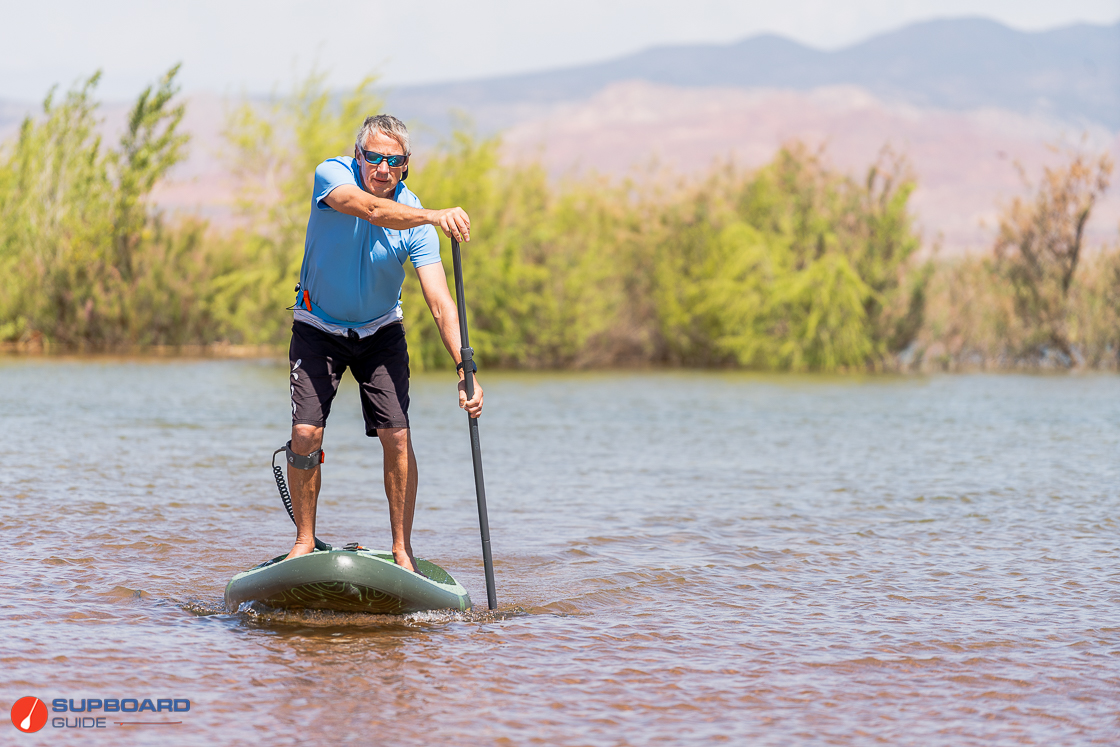
The Retrospec Weekender tracks relatively well for a board of this size and style. Being slightly narrower than its other siblings in the Retrospec range it holds a reasonable line on the water, aided by the three fins under the tail. Again, if tracking is high on your priority list then we’d suggest that the Retrospec Weekender Tour will be much more suited to your requirements, being longer and possessing a more tracking-oriented plan shape. But for general summer paddling where you’re not in any particular hurry to get somewhere, the tracking on this board is quite acceptable.
Maneuverability: 8.8/10
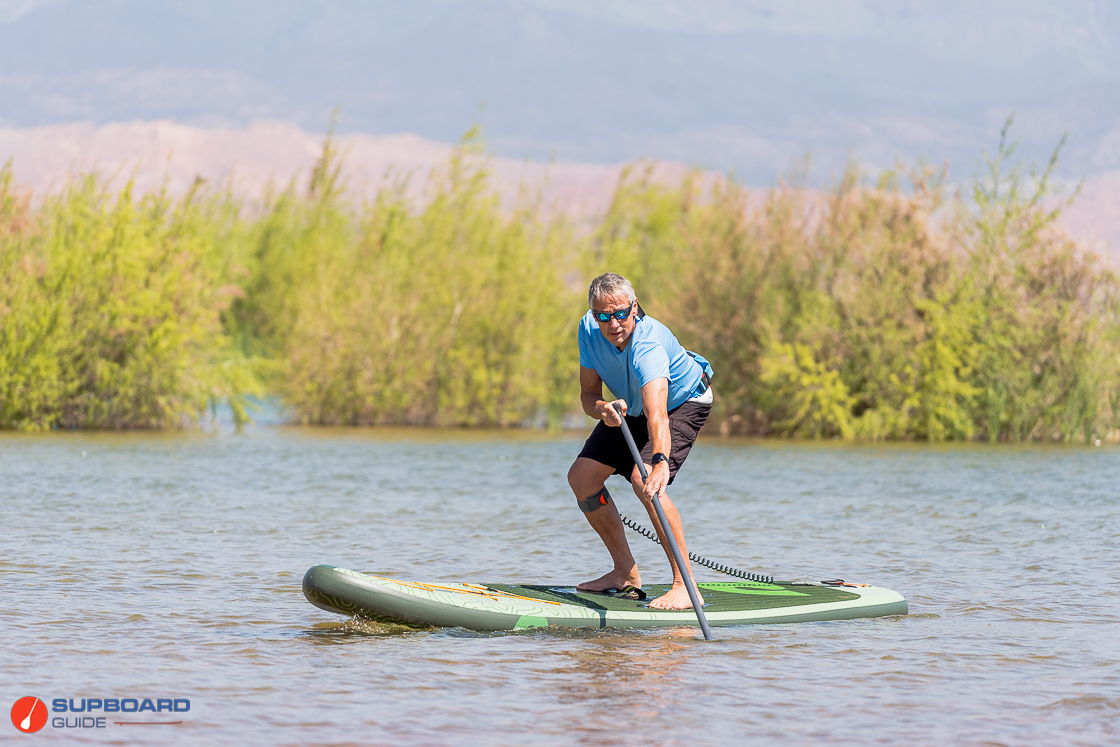

10’6 is a fun size in paddleboarding. It’s the size where boards have enough length and stability to be great for all round general purpose use, but it’s still short enough to allow the board to be really responsive for turning.
This is definitely one of the strong points with the Retrospec Weekender. Being extremely light, and with that slightly pulled-in tail shape compared to the more modern designs in the Retrospec range, it’s easily the best of their all-rounders when it comes to throwing it around a bit. The board is quick and eager to turn, using any type of paddle turning stroke, or when jumping back to pivot it with a tail-sink turn.
If you’re just learning to turn, you should find the Weekender pleasingly responsive. And it’ll be a great platform for learning more advanced turning techniques. (if you really want to jazz things up a bit, remove the two side fins and it’ll be even quicker to spin round!).
Construction Quality: 8.0/10


First things first; kudos to Retrospec for making this board available in no less than seven different color options! Ranging from subtle and understated through to really bright and lively, there should be something here for everyone.
As befitting the price tag, the construction is simple. A single layer of PVC is attached to the dropstitch core, to make it airtight. The result is a very light board that’s low cost to manufacture. Single layer construction is significantly less rigid than double layer construction, and it is easier to puncture. But if you look after the board, you should get quite a few years out of it.
The sides (rails) of the board are constructed from two layers of PVC, which adds extra durability where it’s needed most. These rail panels join at the nose and tail, which is a cost-effective way of doing it but generally considered slightly less strong than having all the joins on the side.
Board Stiffness:


Stiffness Test: 1.625” Bend
While this may seem quite a lot, it’s not actually too bad a reading for a board made of single layer construction. We’ve seen plenty of single layer boards showing over 2” of deflection, and you can really notice that on the water. With the Retrospec Weekender, heavier riders will feel the bend more, but the average weight paddler won’t really find it noticeable until they try to paddle fast or take on significantly choppy water. This is when you notice the flex. But for general paddling in non bumpy conditions it’s not too bad at all, unless you actually start jumping up and down on the board.
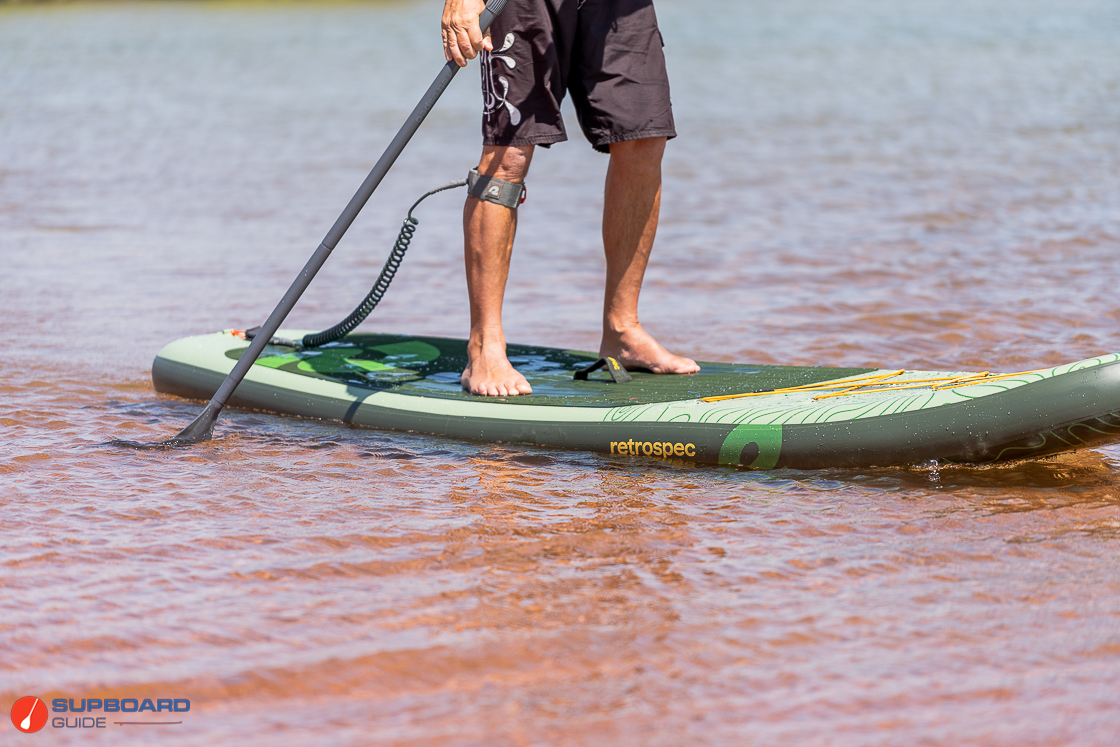
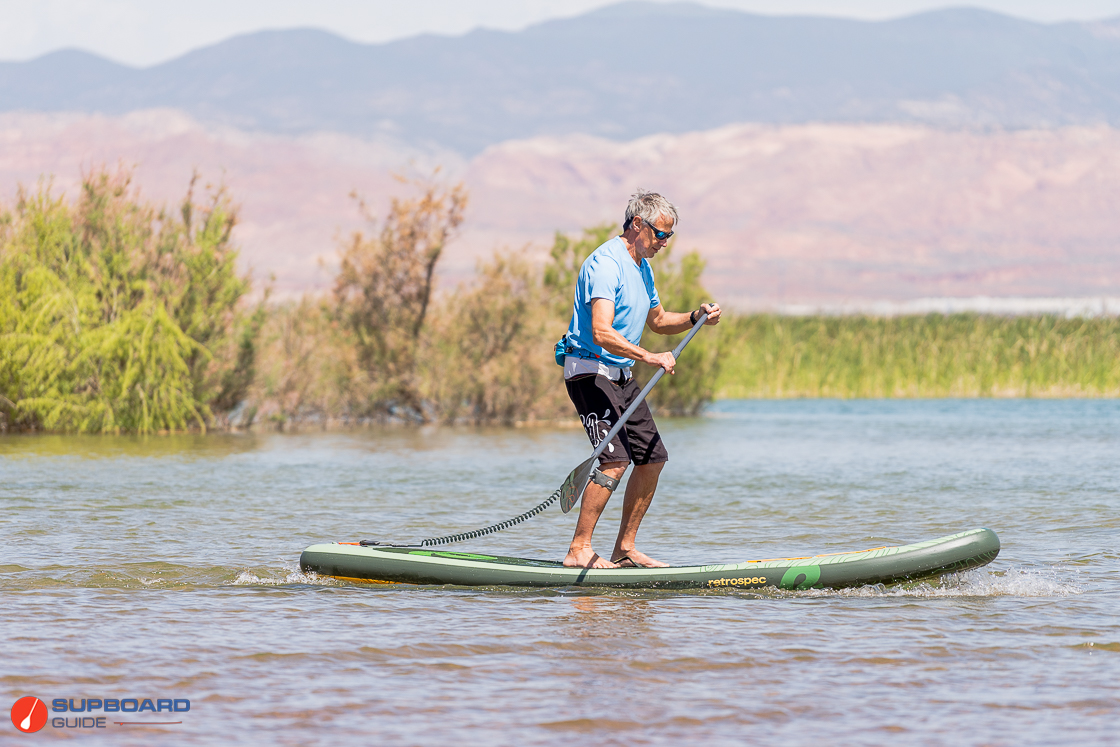
To ascertain the rigidity of each board we review, we use our own specific laboratory bend test process. The board is inflated to its maximum recommended PSI and then placed across two sawhorses positioned exactly 7 feet apart. We then measure the distance from the middle of the board to the floor. Then, we place a 150 lb weight on the middle top of the SUP, and measure the distance to the floor again. The difference between the two measurements shows the deflection, or ‘sag’, that the board has experienced due to the added weight. We have been reviewing the stiffness of boards using this technique since 2021 and while it isn’t an exact replication of the weight distortion that occurs when a rider stands on a SUP board in the water, it still gives a very useful comparative tool in determining the stiffness of the board’s construction process.
Features/Accessory Review: 7.0/10
Features:


Retrospec have kept the Weekender’s configuration as simple as possible in order to achieve that excellent price point. Which is an entirely sensible strategy for a board unlikely to be used for anything much more ambitious than general summer fun. The generously sized bungee fixing up front means you can carry spare clothes, a picnic, cooler or whatever else you decide to take along with you, so it’s perfectly functional in that regard. If you need to carry more, or desire fittings such as kayak seat fastenings, paddle holders, action camera mounts etc, then you only need to spend a few more dollars to upgrade to the Yogi or Plus models which have a much more comprehensive array of fittings.
Because the board is extremely light, it’s perfectly easy to manage with just the one central carrying handle, but even though we appreciate why Retrospec have gone with the super-simple configuration, we did mourn the lack of carrying handles on the nose and tail. They’re so useful on a general purpose board, and also make it easy to tow the board if required. Our suggestion would be to include those on future models, even if it does add a few dollars to the ticket.
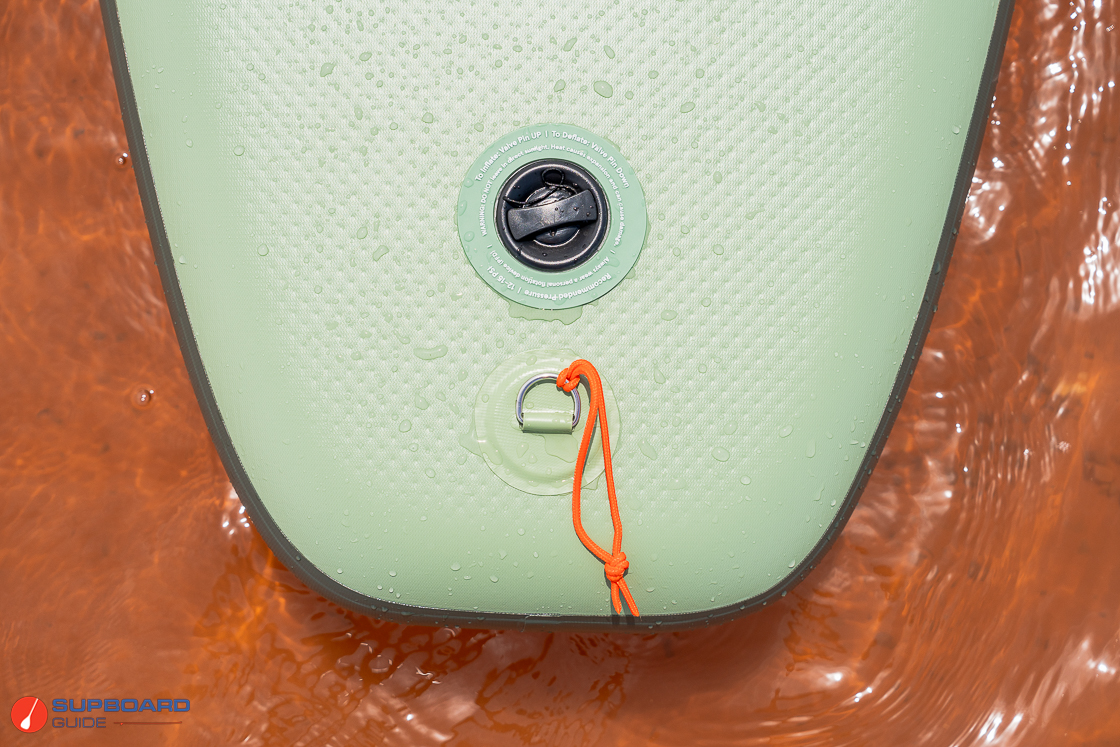
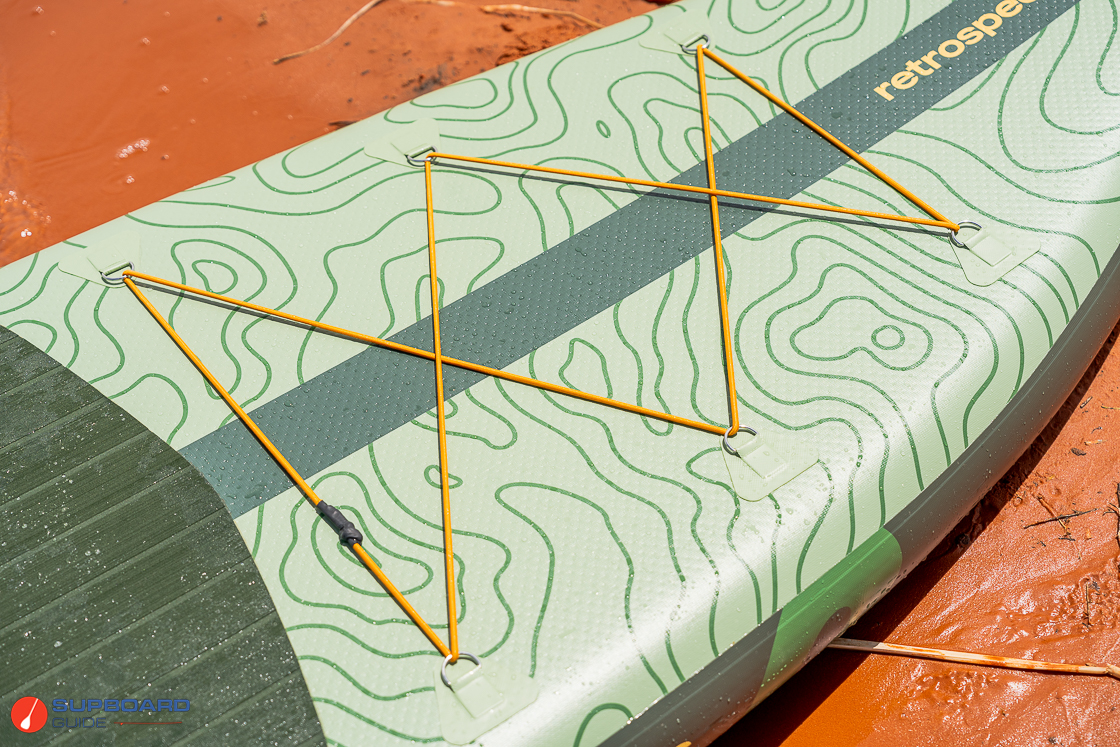

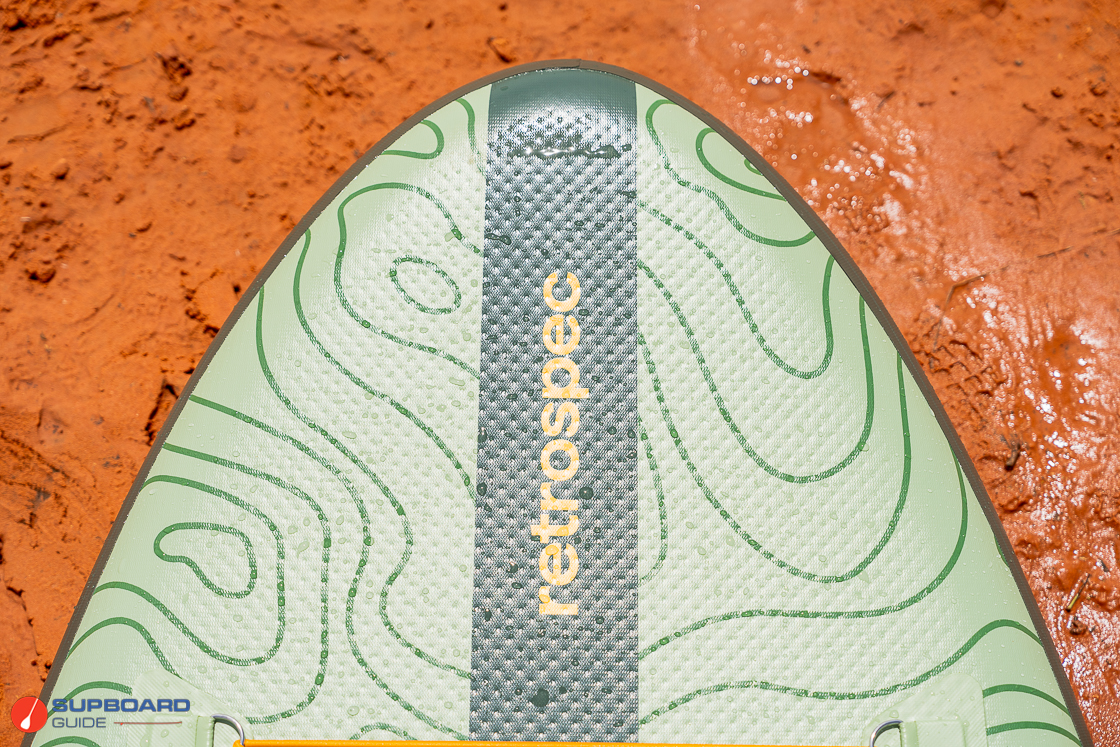
Underneath the board, we find the standard 3 fin configuration that Retrospec uses on all their boards. The fins slide in, and are then locked into place with a pin. Unlike many other slide-in fin systems we’ve tested, these operate really easily – full marks to Retrospec for finding a slide-in fin system that actually works!
There are no other fittings on the underside.

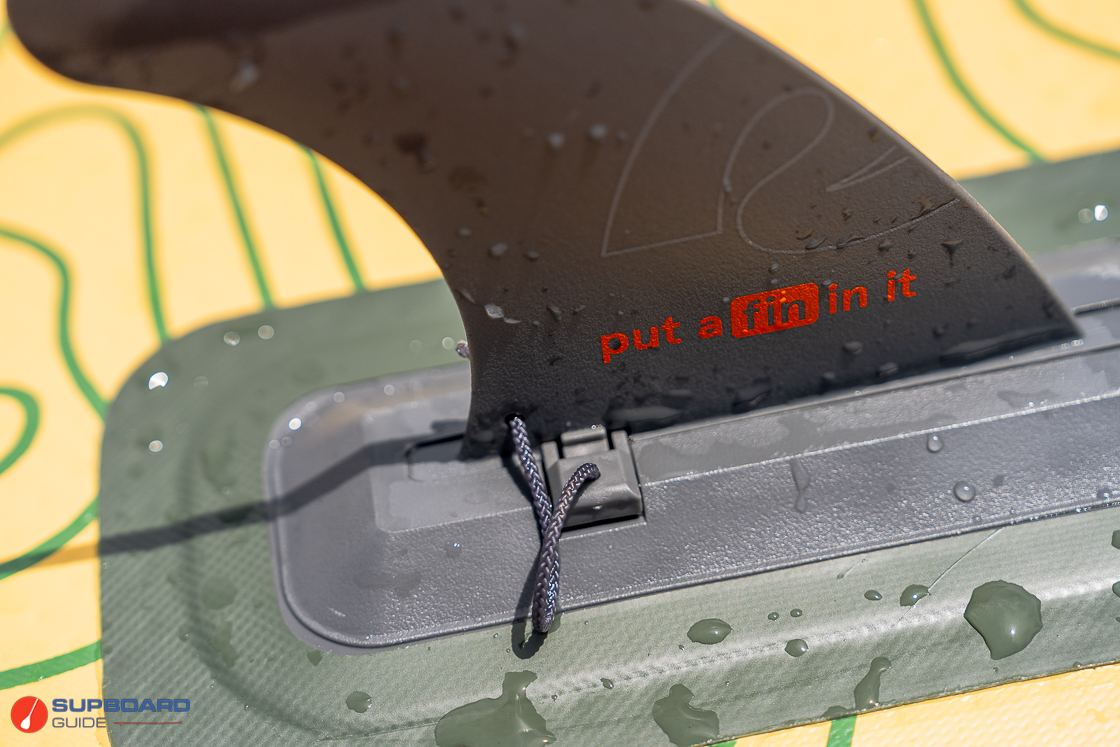
Included Accessories:
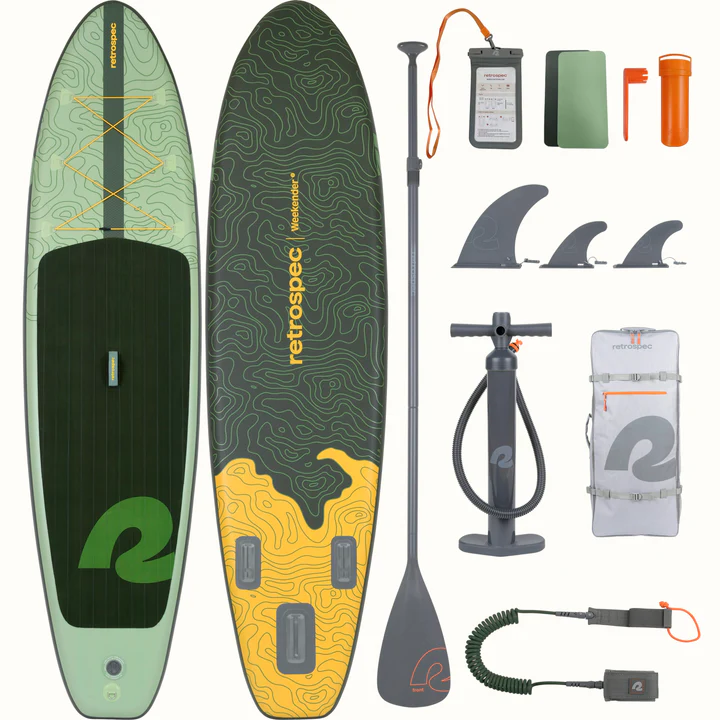
The 3 piece adjustable Retrospec paddle has a nylon blade and an aluminum shaft, which is typical of boards at this price point. However, this is definitely one of the better alu paddles that we’ve encountered in terms of performance, and the brushed finish looks quite classy too. Our usual advice with alu paddles is to upgrade to something better as soon as possible, but for general recreational summer fun paddling, this blade is actually alright. Which makes the package price even better value!
The dual action hand pump works OK. It’ll be tempting to pay the extra $99 at check-out to get the electric pump, but don’t feel that you have to, if you’re looking to keep your expenditure as low as possible. Inflating a board with the hand pump is actually considerably quicker than using an electric pump, and a whole lot quieter! Once you’ve done it a few times by hand, and worked out how to pump properly (arms straight!), it’s really not too onerous. Electric pumps are great, but they shouldn’t be thought of as an absolute necessity.
The backpack kit bag is comfortably big enough to make packing the board away easy, and it has padded shoulder straps, a hip belt strap and a separate front pocket for the fins. Again, a surprisingly nice bag considering the overall package price.
Summary Review of the Retrospec Weekender
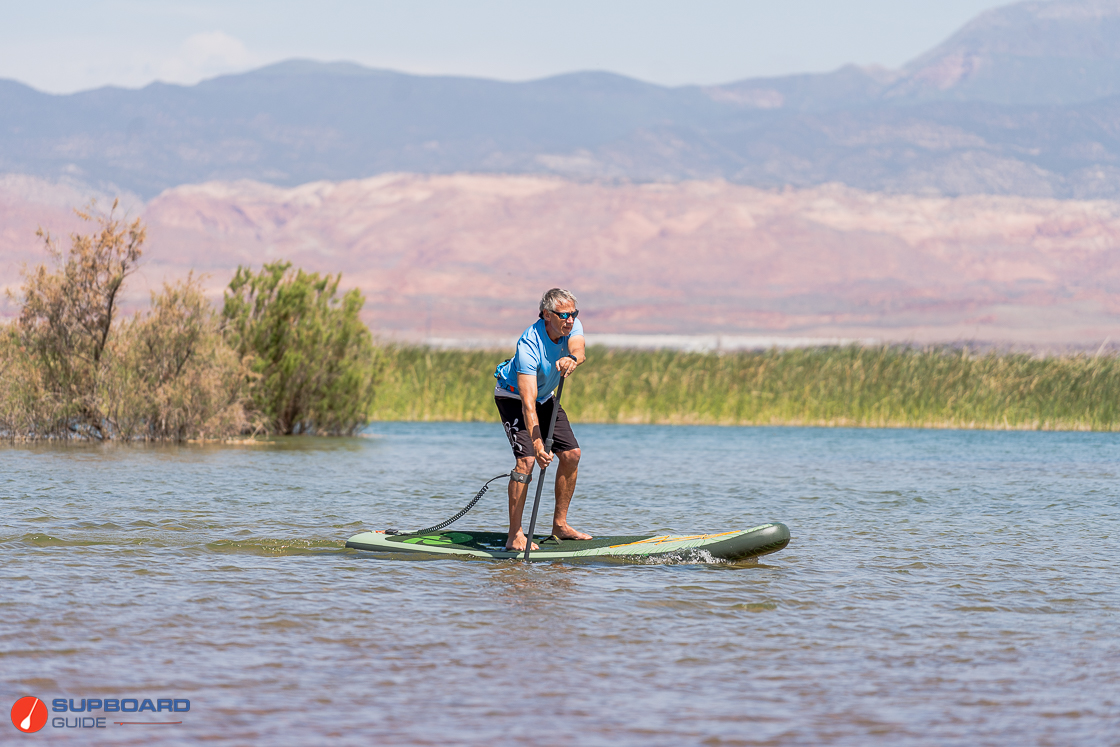
This is quite a challenging board to review, because of where it sits in the market. We’re very spoiled here at Supboardguide.com; we regularly get to play on some pretty expensive toys, costing 5, 6, even 10 times more than the Retrospec Weekender. And for sure, they’re better in every single aspect of construction and performance. But are they 5, 6, 10 x better? Are we having 5, 6, 10 x more fun on them? No, we’re not.
Something we see and hear all the time on facebook groups and social media chats; “I don’t want to spend too much on my first board because I don’t know if I’ll like it”. Which is always a worry, because all too often, that person actually ends up buying something really bad. (Trust me on this, there are plenty of really bad paddleboards out there.). And, surprise surprise, they have an extremely mediocre experience on their low-quality paddleboard, and decide that the sport isn’t worth getting into.
This won’t happen on the Retrospec Weekender. For sure, it’s a no frills, basic paddleboard. But it works. And you’re buying from a real brand who actually have paddleboarding expertise in their team – and have been around for quite a few years. So if you have a problem, there’s a pretty good chance you can talk to someone about it. Whereas most boards being offered at this price point aren’t from an actual ‘brand’ at all, just someone cashing in on the trend.
So, we aren’t going to nitpick about the details of what makes this board what it is. What you need to know is that if your budget is $249 for a general summer fun paddleboard then this package will be a good investment for that money. If you can afford to spend a bit more, then yes, definitely look further up the Retrospec range. You will get more performance, more accessories, fittings and fixings. But if you don’t want to spend any more, then you’ll be hard pushed to find a much better deal than this.
Happy paddling! We hope you enjoyed this review of the Retrospec Weekender. If you have any questions or comments please leave us a comment below!
SupBoardGuide
Latest posts by SupBoardGuide (see all)
- Best Paddle Boards for Beginners, 2025 - July 3, 2025
- Hala Radito Whitewater iSUP Review – 2025 - June 27, 2025
- Hala Atcha 96 Whitewater iSUP Review – 2025 - June 16, 2025


